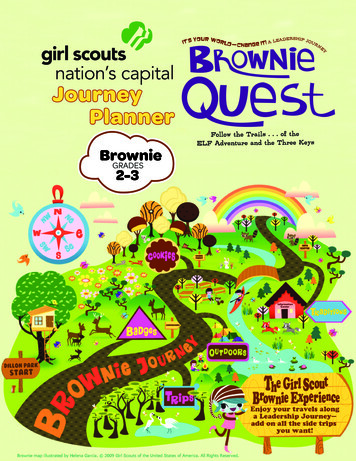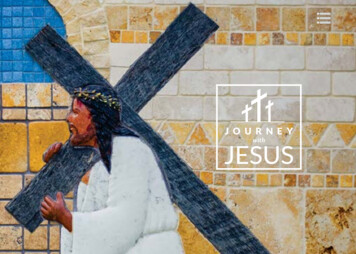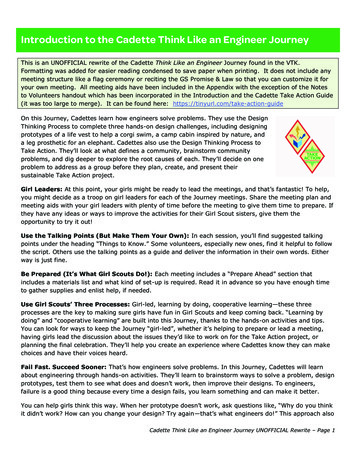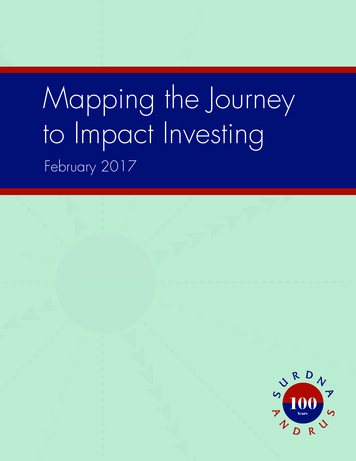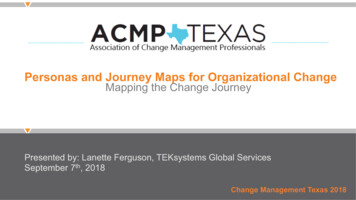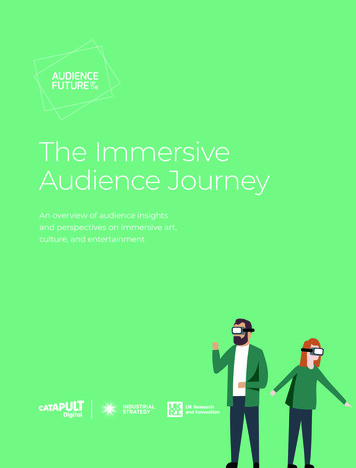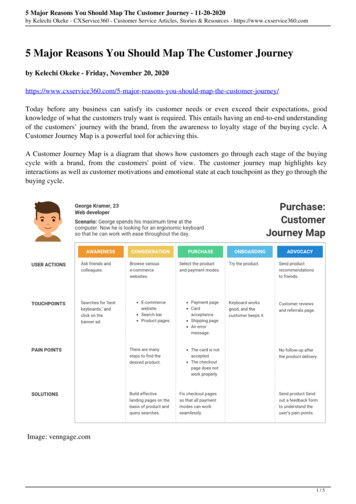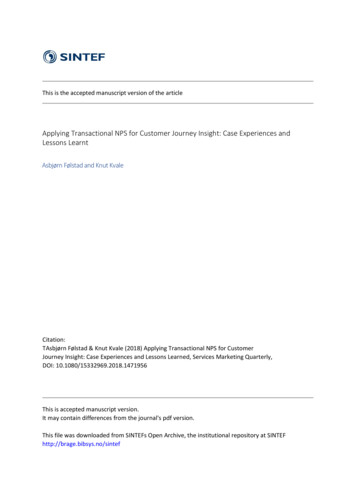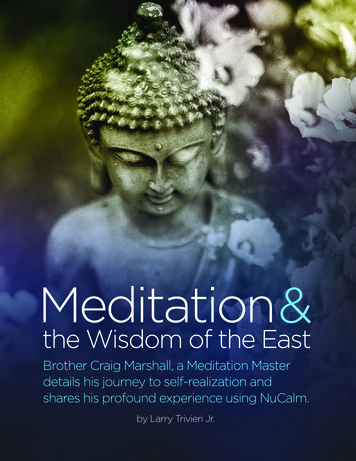
Transcription
1
The Beginning of a Journey to Self-RealizationFew people can claim to have had as varied, distinguished, and interesting lifejourney as the one Brother Craig Marshall continues to have. From his time as achild actor who forged friendships with Ronald Reagan, Donna Reed, and ShirleyTemple, to serving in the U.S. Army Security Agency, to his 35 years living as amonk in a monastery mastering and teaching meditation, to his friendships withsuch luminaries as Steve Jobs and George Harrison, to his current career as apublic speaker, workshop leader, and transformational life coach and “businessbodhisattva” within the corporate world, Craig has lived his life guided by hiscommitment to self-discovery and his dedication to serving others and helping themto discover and fulfill their unique life purpose.In recent years, Craig has also become an advocate of NuCalm because of howquickly, easily, and predictably it enables him to access a state of consciousnessor awareness, which typically takes a long and regular practice of meditation toachieve. To that end, Craig also wrote the Preface for the book A New Calm, whichtells the story of NuCalm’s development and explains its many benefits.In reflecting on his life journey, Craig says, “I’ve lived many lives in this life! I’vebeen an actor, baseball player, Boy Scout, army recruit, photographer and filmdirector – before I was a yoga monk, minister, public speaker, consultant, life-coach,ghostwriter, and now a householder. Through all these roles I’ve navigated a processof self-realization, learning and un-learning, experiencing a deeper understandingthat I am something greater than anything and everything I was seeking. Behind itall, there was always my deeper self and my unique life-purpose.”2
Craig’s quest to know more about himself, and about life, began at an early age. “Ialways questioned things,” he says. When he was ten years old, he attended thefuneral for a friend of his family. That experience powerfully moved him to seek theanswers to life’s biggest questions. “I grew up in Los Angeles and my parents werevery balanced, healthy people. They were married for their entire adult lives andwere actually childhood sweethearts from Kentucky. Thanks to them, I grew up ina very loving, supportive nest. My parents were very happy. They were living thelives that they wanted, yet I wanted something more. I didn’t know what it was atthe time, but I just had the sense that there is more to this game of life than I sawmost people getting.”Craig’s desire to know more about the answers to life’s biggest questions onlygrew deeper during his time as a successful child actor in Hollywood. “I was onhundreds of television programs and commercials, soI grew up around dynamic and creative people andCraig on the TV show Room for One Morea lot of celebrities. I enjoyed that because it was funand certainly beat going to school, but I saw that therewere a lot of people in that industry who were kind ofinsecure. That spooked me a bit and fed my own desireto seek what I would just call ‘something else’.”During this time, Craig met his first three mentors, allof whom he credits with having a deep and positiveinfluence on him. “The first one was Ronald Reagan,” herecounts. “I met him when I was 13. He was president ofthe Screen Actors Guild at the time. I had some problemswith the union, so I got to know him and his family andhe sort of took me under his wing. He was one of the kindest people that I have evermet, a real gentleman and a very caring person.“I then did a number of live television shows with Shirley Temple, who was by thenan adult and a very accomplished, mature, and what I would call conscious person.She later went on to become a U.S. ambassador and had a very dynamic life. I alsowas on The Donna Reed Show a number of times and I knew her and her husband,Tony Owen. In real life, Donna was just like she was on TV or in that fabulous movieIt’s A Wonderful Life. She was like the perfect mom.“Those three people were really a contrast to all of the Hollywood wannabes. Theyhad a depth to them and a maturity that was very appealing to me,” Craig says. Inpart because of their influence, he decided to attend film school at the University ofSouthern California (USC), and graduated with a degree in public relations and filmproduction. During this time, he enlisted in the Army and was on active duty in theArmy Security Agency during the Vietnam War.It was at that point in his life that Craig knew he had some important consciousdecisions to make about his life and career, yet he felt incapable of making them. “Isaw myself as a sort of restless, superficial person without any motivation, depth, orclarity about my life,” he admits.3
While in the midst of this quandary, he discovered and read the spiritual classicAutobiography of A Yogi by Paramahansa Yogananda, founder of the SelfRealization Fellowship (SRF), who was one of the first yogis from India to popularizeyoga and meditation in the United States. After reading the book, Craig visited theSRF temple in Hollywood, where he soon began to work for the organization. “Therewas a restaurant there at the time, and there were a lot of young people there then.It was a very dynamic and popular watering hole for spiritual seekers and newthought leaders,” he says. “I began toying with the idea of becoming a monk, butthen I thought, ‘I don’t have the discipline or maturity to lead that kind of life.’”By then, Craig had already started to meditate, and that is where he found theguidance he was looking for. “In meditation one time I had this proverbial turning onof the light bulb experience,” he recalls. “I gained a sudden clarity of absolute truthas I heard this inner voice say, ‘Just this once, don’t do what you want to do, but dowhat you know you should do.’ And that decided me. Though I still didn’t think Iwanted to be a monk because it seemed like a struggle and something over my head,I nonetheless felt like I should do it, and that it would be good for me because of thediscipline, structure, and support I would find living in the SRF monastery.”Discovery & CommitmentThere was only one problem - Craig was stillactive in the Army Reserve at the time andhad four more years to go before he fulfilled hisobligation. “The people at SRF told me they didn’tthink I could become a monk at that time becauseof this,” he says. “Yet this vision and guidance I hadreceived while meditating told me I was supposedto be a monk and I was committed to doing that.”That was when Craig started to discover what canhappen when you discover and commit to followingyour inner guidance. “I went down to my Army unitand walked into the office of my commanding officerand told him, ‘I’m sorry, sir, but I’m going to have to leaveyour unit,’” he says. “He asked me, ‘Why is that?’ andI told him I was going to be a monk and wouldno longer be able to attend weekend meetings,and summer trainings, and so forth. This was in 1969, during the heightof the Vietnam War, so I was surprised when, instead of denying myrequest, he simply wrote up an application for my discharge, which Ireceived three weeks later. It was a total left turn from what I expected,and soon thereafter I entered the SRF ashram [monastery].”This phase of Craig’s life began when he was 23 years old. He livedas a monk for the next 35 years. “In the ashram, I learned more aboutmeditation and concentration and lived a life of service,” he explains.4
“I was mentored by an inspired and saintly monk.After a dozen years, I was ordained a swami andwas given the name Brother Mitrananda, whichmeans ‘bliss through friendship’. For 15 years I wasresponsible for training the youngest monks, andbecame a minister and public speaker, addressinglarge audiences around the world.”As a result of the training Craig received as a monk,today he is recognized as a leading authority onmeditation. He estimates that he has spent 50,000hours of his life meditating, both privately and in group settings. “Meditationreally changed my life,” he says, “because, over time, I began to experience statesof consciousness that deeply informed my core sense of self. I had never felt suchpeace, love and joy.”Stilling the Mind With MeditationAlthough he is no longer a monk, Craig remains a strong proponent of meditation.In recent decades, scientific research has uncovered many positive physicaland psychological benefits that meditation can provide, in addition to itsmillennia-long stature as a spiritual practice of self-discovery that it holdswithin all major religions around the world. According to Craig, yogisteach that, on average, most people think one thousand thoughts eachhour. “That’s a thought every two and two-thirds of a second,” he says.”It’slike thought, one Mississippi, thought, two Mississippi, and so on. That’s thetempo. We think all of these thoughts, yet we don’t even know where ourthoughts come from. They’re like champagne bubbles that bubble up fromour subconscious mind, or from outer stimulation or circumstances.“For thousands of years, the yogis have recognized that themind cannot control itself directly. That’s why they developed theseconcentration and meditation techniques, which act indirectly. Youdon’t start off trying to will your mind to concentrate because itwon’t work. The mind is as much our enemy as our friend, at thatstage. That’s why breathing exercises are used as a starting point.”There are many different types of breathing exercises, Craigexplains, and many of them are ancient and still practiced todaybecause of how effective they are. For beginners, though, Craigsuggests simply breathing normally and observing your breath.“Just become aware of your breath coming in and out throughyour nostrils,” he instructs, “sitting comfortably with yourspine straight and your eyes closed and gently raised upwardto the point between and slightly above your eyebrows. Asyou observe yourself breathing, your breath will slow downrelatively quickly.”5
It is this slowing down of the breath that provides the first possibility for selfdiscovery that meditation affords, according to Craig. “As the breath slows down,” heexplains, “the intervals, or gaps, between inhalation and exhalation, and exhalationand inhalation start to widen. In those gaps, there is an opportunity to go to a deeperlevel, which I would call your higher or inner self, or your intuition, allowing youto tap into your inner guidance. You can’t do that in the midst of the thousandthoughts per hour drumbeat. That’s the first stage of meditation, slowing thingsdown and de-stressing.“After that comes a state of concentration offocus, and then after that meditation properbegins, where you rise above what youmight call the mediocrity of average humanconsciousness. I think throughout history this iswhat the saints and the masters and the heroesand geniuses have been able to do. This state ofawareness and focus is really the launch padfor creative and innovative ideas that are thebreakthroughs that people are looking for, bothin their personal and professional lives. It startswith slowing down the bubble machine of thoughts and then learning to focus andgetting a very clear picture of what you want on a deeper level. And what we findout intuitively is that what we want are not things or outer circumstances.“Most people live what I would call circumstantial lives. They have a belief systemthat says to them, ‘When I accomplish this, whatever it is, then I’ll be happy.’This postponement of happiness and dependence on external things and eventsto be happy reminds me of when I was a freshman in college taking a course inEconomics 101. In the preface of thetextbook, in italics, was the definitionof economics. It said, ‘Economics isthe study of man’s attempt to satisfyunlimited desires with limited means.’When I read that, I thought to myself,‘Damn, this game is impossible bydefinition.’ That fed into my suspicionof normal living. I wanted somethingmore. I didn’t know what it was atthe time, but I had a sense that there’smore to life. What I wanted to dowith meditation, yoga, and beingCraig with Ringo Star anda monk was to sort of offload myhis wife Barbara Bachprogramming, if you will, and explorenew ground and really be creative and figure out who I was and what I reallywanted on the deepest level. Through meditation, I learned to go deep. I’m not adeep person, yet now I’m able to unplug from all these mind games and limitations.”6
Brother Craig’s New Beginning“After 35 years living as a monk, my life took a second left turn,” Craig says,explaining how he has come to be a highly regarded transformational coach, publicspeaker, and business consultant. “My karma and dharma thrust me back into theworld, which led me to develop a new life, a new role, and new sense of Self.” Inhis new life, he also met his wife and today is happily married and, as he calls it, “ahouseholder”. He still continues to meditate, yet in recent years he has added theregular use of NuCalm to his ongoing adventure in self-discovery, mindfulness, andgreater awareness.How Craig became aware of NuCalm dovetails with his exploration and practiceof what is often referred to as the law of attraction. “As I’ve gotten clearer on howlife works and what I wanted and didn’t want,” he says, “I realized the primary lawof life is that you get what you think about, whether you want it or not – meaningthoughts are proto-things. Even in quantum physics it’s a law. What you focus onexpands. Now that I understand that a little bit more, I’m much more disciplinedabout what I think.”Another guiding principle for Craig is a quote from Deepak Chopra that his wifeshared with him: “According to Vedanta [the study of the Vedas, consideredto be the oldest written records in the world], there are only two symptoms ofenlightenment, just two indications that a transformation is taking place within youtoward a higher consciousness. The first symptom is that you stop worrying. Thingsdon’t bother you anymore. You become light-hearted and full of joy. The secondsymptom is that you encounter more and more meaningful coincidences in yourlife, more and more synchronicities. And this accelerates to the point where youactually experience the miraculous.”
“When I first read that quote about three years ago, I thought that is exactly what ishappening in my life,” Craig says. “I’m lightening up, I’m not worrying, I’m ten timesmore joyous than I was even five years ago, and these synchronicities are starting toreally happen more frequently.”One such synchronicity occurred when Craigmet Jim Poole, the CEO of Solace Lifesciences,Inc, the makers of NuCalm. The meetingoccurred in a hotel in Los Angeles. “When Imet Jim, I just knew he was meant to be in mylife,” Craig recalls. “And when I met his brotherDavid [David Poole, Executive Vice President,Sales and Marketing for Solace Lifesciences,Inc.], it was the same thing. I immediately feltlike these are my people. It wasn’t NuCalmthat interested me, although I was certainlyinterested in it. It was more like there was afield of energy and Jim, David, and I were all apart of it, and so was Blake [Dr. Blake Holloway,the inventor of NuCalm] and the other peoplethat are part of the NuCalm family. I regardthem as part of my tribe. They’re very cool andconscious people, integrated in a way that Irespect. That’s really what drew me to them.”Jim Poole, CEO of Solace Lifesciences,Craig’s wife, Carina, and CraigBecoming A NuCalm BelieverAfter Jim explained that NuCalm is the world’s only patented technology clinicallyproven to quickly and effectively reduce stress and improve performance withoutdrugs, he presented Craig with a NuCalm unit. “I went home and tried it out,” Craigcontinues. “I didn’t have any expectations except that I believed what Jim had toldme was true and I thought it could be valuable. I lay down in bed, put NuCalm onand it got me almost immediately into a state that I would not be able to definebecause it was somewhere between sleep and wakefulness.“I’m not a scientist, so I don’t care how NuCalm works from that perspective. I’m notreally interested in the vibratory frequencies of beta, alpha, and theta brain waves.I don’t know what NuCalm does on a vibrational level, but I know it has to do withvibrations because everything does. Everybody’s energy, energy moves, and we callthat movement vibration. Those moving vibrations have certain frequencies andcertain frequencies can combine with other frequencies to create either resonanceor dissonance. That’s about as far as the science goes that I want to understand. Ido know that NuCalm makes a shift state in me almost immediately. That’s what Ireally love about NuCalm. When I use it, there is no lag time in getting me out of mynormal thousand thoughts per hour, senses-bound mind.”8
Comparing NuCalm to meditation, Craig says, “When you meditate, you are startingto knock on the door to another realm, which I think the saints and masters andother deep people through the ages realized is the beginning of opening new vistasof experience, and therefore you are able to touch your intuition. When you start toaccess that realm you get incredible insights. You get clarity and out of that claritycomes confidence. When you’re clear and confident, that sets up a magnetic fieldaround you that can draw you to people and new opportunities. Things start tohappen and you really start to speed up your ability to create and innovate.“I think NuCalm is a launch pad for starting that process. It doesn’t take the placeof meditation, it doesn’t make you more conscious by itself, but it is most definitelya de-stressor and a state shifter that allows me to almost effortlessly go intomeditation, or think more creatively, or to focus on a deeper level. All three of thosebenefits are worth all the tea in China.”Because of the many benefits he’s derived from NuCalm, Craig uses it regularly.“Most of the time, I use it every day,” he says. “Sometimes, when I’m traveling or getdistracted I use it a little bit less. I always beat myself up when I don’t use it. I say tomyself, ‘I’ve got this tool, this magic genie’s bottle, so why am I not using it?’ I stillmeditate on a regular basis and I still do things like reflection and journaling andother creative things, but NuCalm is a big tool in my tool kit now, and wheneverI use it I get the same results, that quick shift into what I call state of calmness andclarity. My family uses it, as well, and I’ve turned some of my friends onto it. I thinkin the future the science behind NuCalm will be much more understood, and whatexcites me about NuCalm is not just its proven de-stressing capability, but its abilityto help people quickly and predictably access that state of deeper awareness. Thisstate that NuCalm produces is a platform from which people who use it can start tomeditate and think and act more creatively.”Pointing out another difference between meditation and NuCalm, Craig explains,“Meditation presupposes concentration, and concentration is a discipline. It takeswill power and discipline to be able to concentrate and meditate. With NuCalm youdon’t need those things because it just takes over. NuCalm gets you to that firststate of peace by itself. I see NuCalm as a great gift for people who arerestless, or who have limited attention spans or limited time. If Ijust sit down to meditate without NuCalm, sometimes it takes me15 to 20 minutes to get to that null point where I move beyondmy day-to-day thoughts and memories to be able to reallyfocus on what I want to focus on. NuCalm gets me there muchfaster. I think NuCalm is a great entry point for anyone whowants to experience those deeper states of mind but doesn’thave the discipline or the time to devote to meditation.”“In addition to NuCalm’s ability to quickly reduce mystress and engender clarity and peace, I also find thatNuCalm produces feelings of rejuvenation. It helps melighten up. I would call the state of consciousness that Iachieve through NuCalm a transcendent state.”
NuCalm as a Tool For ChangeCraig also sees NuCalm as a tool to help people become better able to help promotepositive change in society. “These days, with all of the things that are going on inthe world, I think most people believe that the world is in a fragile state and at risk,and that it really needs to change” he says. “I don’t believe that because I think thefunction of the world is to be a mirror, and the only way we are going to changewhat we see in the mirror is to change what we are projecting onto it. I think Gandhiwas the extreme example of this, of taking complete personal responsibility. He said,‘I have three enemies, the British, the Indian people, and myself. I’m by far the worst.But I’m the only one I have potential control over.’“If we were to draw an evolutionary line between the lowest states ofconsciousness, which you might call savagery, up to the highest level, whichyou might call mastery, I think that the through line would be taking moreand more personal responsibility. That’s why I use NuCalm. It allows me tobecome calmer and clearer. That’s the word: Clearer. Because clarity of purposeis the core of every endeavor. When you’re clear that means you’re intuitive.Clarity is magnetic in nature. When you speak about what you really knowpeople are going to listen, and that’s how you can make a contribution. That’show you can positively influence other people. NuCalm can help you to dothat. And I think it is especially beneficial and really helpful for people whostruggle to get through the day, or who rely on drugs or some other crutchto cope with life. I think NuCalm can be a complete replacement for thosecrutches they need, and it certainly is a much healthier way and a moreconscious way to tune into who we really are on a deeper level.”Asked what he would tell people considering trying NuCalm for the first time, Craigsays, “First I would ask them what interests them about something like NuCalm andwhat would they like out of it, so that I addressed their needs and their expectations.I’m happy to share my experience with NuCalm, yet there’s nothing that takes theplace of one’s own experience. Because there is science behind NuCalm peoplewho try it are going to have somewhat repeatableresponses and experiences with it, but I dothink that everybody also has their ownunique experiences with it and there is nosubstitute for that.10“I would also tell people what NuCalmhas done for me. In my world, thegoal is only three things, and that’speace, love, and joy. That sounds likea generality on a bumper sticker, butit’s not. If something promises me anyone of those three I would check it out,and in my experience NuCalm is anexternal device that can change yourinternal consciousness.”
“Before NuCalm, the idea that an external, material device could affect myinterior consciousness and speed up that process was totally new to me, yetit has done that every single time that I have used it. I get these predictable,scientific results of being in another state that is calmer and clearer, with moreenergy, clarity, focus, and depth, and every one of those things is really, reallyimportant to me. I know I can count on NuCalm and that it will take me to adeep, fulfilling, nurturing state that allows me to come out on the other side tobe more productive. And not to just get more work done, but to get that workdone in more profound and meaningful ways. If I had had NuCalm when I wasa young adult, I think it would have helped me become a deeper thinker and Iwould have made even healthier and more creative decisions in my life.”“Finally, I would let people know that there is a four-step process to using NuCalm.The first step is to sit or lie down. The second step is to mentally “shut up” and let goof any mental burdens. The third step is to turn on NuCalm. And the fourth step isto trust that process that will take you within. I believe that each of us has a uniqueLife-Purpose. We all have a special insight into our innermost core. Despite all thecomplexities of life, we all still have a deep inspired inner knowing. It’s the essenceof who we are. When people learn to live in alignment with their personal LifePurpose, they begin to experience a continuing series of so-called ‘miracles’. I see thisevery day. NuCalm can help foster that alignment. That’s what I would tell peopleand it’s why I wholeheartedly recommend and endorse NuCalm.”11
Autobiography of A Yogi by Paramahansa Yogananda, founder of the Self-Realization Fellowship (SRF), who was one of the first yogis from India to popularize yoga and meditation in the United States. After reading the book, Craig visited the SRF temple in Hollywood, where he soon began to work for the organization. "There



